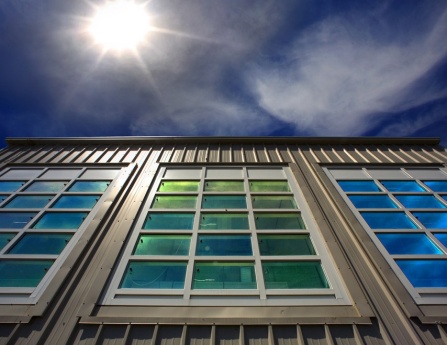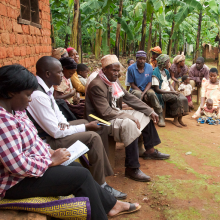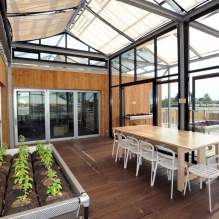Issue #1: Climate change

A terra cotta assembly developed by faculty at the School of Architecture and Planning is among several studies exploring passive energy building systems.
The challenge of our time
No other human activity has a greater impact on the climate crisis than the planning, design and development of the built environment.
The construction and operation of buildings alone accounts for 39 percent of global greenhouse gas emissions. Where we locate buildings and development is directly related to the next highest source of emissions: the transportation sector (automobiles, trucks, airplanes and shipping), which generates 29 percent of annual C02 emissions (Source: United Nations Environment Program). Rapid urbanization is among the greatest climate threats as it both swallows arable land and expands the global built footprint. Concentrated populations, including marginalized, informal settlements, are particularly vulnerable to extreme weather events and rising sea levels.
Indeed, the design and planning decisions we make today across our built environment - the materials and methods we use to construct buildings, the policies and investments that shape where we build, and even how we live within those spaces - will determine human climate impacts for centuries to come.
This same burden of responsibility, however, implies the magnitude of possibility for those who design, plan and build our cities to shift the climate crisis trajectory and perhaps the future of our planet. Embracing the potential of our disciplines as agents of change, the School of Architecture and Planning places climate action at the center of its teaching and research
Commemorating our 50th anniversary, "Be the Plus" invites you to join us in considering new possibilities for our disciplines as creative, innovative and regenerative forces in our world. Learn more about Be the Plus.
Issue #1: Climate change
New features

"The majority of building-related professionals [interviewed for our project] assumed that future weather conditions would resemble the past. But trends in the data show that this is not the case." Nicholas Rajkovich shares findings from his research on climate-adaptive design strategies in The Conversation.

Reflecting the urgency and centrality of the climate crisis to the work of architects, UB alumnus James Hartford (MArch ’95) describes it as a “newly understood force – a force that we must account for in our designs just as we deal with Newtonian gravity.” Hartford says the profession has the opportunity to take the lead in addressing what has emerged as an existential threat for our planet.

UB played a central role in earning a designation for the Niagara River Corridor as the 40th Ramsar site in the U.S. The corridor joins more than 2,300 wetlands worldwide recognized for their rare habitats and biological diversity. The Ramsar Convention on Wetlands is an intergovernmental treaty that provides the framework for the conservation and wise use of wetlands and their resources.
Faculty research on climate change

Preparing buildings for climate change
Are current buildings - and the codes and policies that regulate them - prepared for the predicted increase in extreme weather events as the climate crisis worsens? These challenges and solutions to address them are detailed in a series of reports recently completed by UB resilience expert Nick Rajkovich and his Resilient Buildigns Lab.

Sensing thermal extremes
Extreme temperature events cause greater mortality rates than all other weather-related events, with those in low-income and traditionally marginalized communities most at risk. A national study co-led by UB will assess these risks and develop macro and micro strategies that build urban climate resilience for all residents.

Training citizens as change agents
The Citizen Planning School trains citizens to effect change at the local scale on sweeping global issues including climate change, economic inequality, and social justice. The program graduated its latest class of nine Champions for Change with diverse plans for regenerative development in their own neighborhoods.

Climate impacts on food systems
Research by UB's Food Lab and Community for Global Health Equity reveals that climate change impacts compound existing economic challenges faced by small-holder farmers around the world, threatening a critical link in sustainable food systems at the local and global scale.

Energy, technology and lifestyle
Architecture professor Martha Bohm assesses the design process and performance of UB's net-zero energy prototype, the GRoW Home. Designed for (and placing second in) the 2015 Solar Decathlon, the GRoW home features an integrated greenhouse and occupant-controlled thermal systems.

Habitecture in the Australian desert
Architecture professor Joyce Hwang's "Life Support" is a living art sculpture that transforms a dead, 400-year-old tree into functional habitat for bats, birds and reptiles. It was installed over the summer in an ecological offset zone in Canberra, Australia, in collaboration with the region's parks and conservation department.
Alumni contributions on climate change

Socio-ecological design futures
In the recently published book Design with Life, alumnus Mitchell Joachim (BPS ‘94) and Maria Aiolova chronicle projects developed by their nonprofit organization, Terreform ONE, that define new directions in socio-ecological design and intersections of synthetic biology, architecture and urban systems.

Coastal city preparation
Doctoral research by urban planning PhD graduate Tu Dam Ngoc Le examines climate adaptation strategies for 45 coastal regions in the developing world. Her work reveals a complex policy landscape challenged by socio-economic sensitivity, insufficient infrastructure and limited adaptive capacity.

A provocation on ocean pollution
The New York City pop-up exhibit "Ocean Cube" has wowed thousands of visitors with its playful reflection on ocean pollution. Co-designed by Randy Fernando (MArch '18) and fabricated in our shop, the project has garnered reviews in the New York Times. It's on view through Oct. 23.
How are you pushing the "plus" of future practice in our disciplines? Tell us how for a chance to be featured on our "Be the Plus" blog. Contact Rachel Teaman, assistant dean for communications: rmansour@buffalo.edu